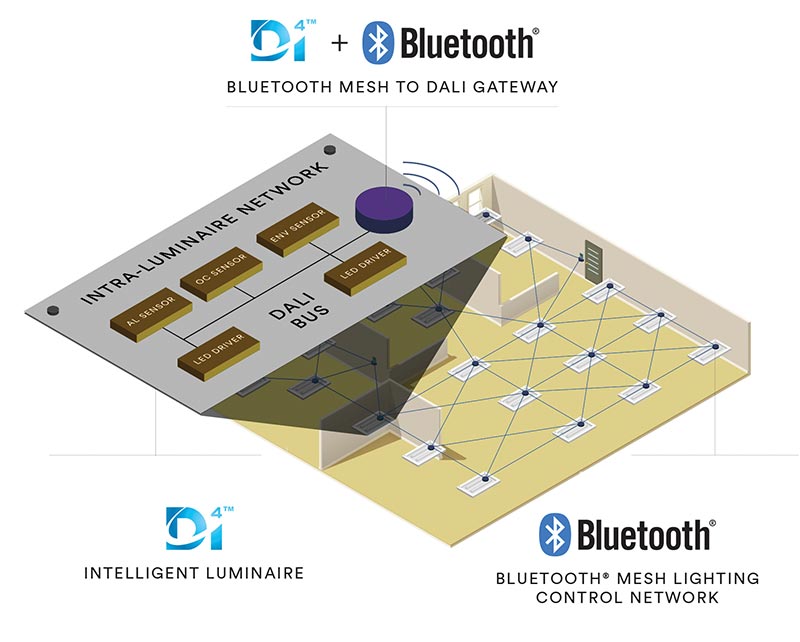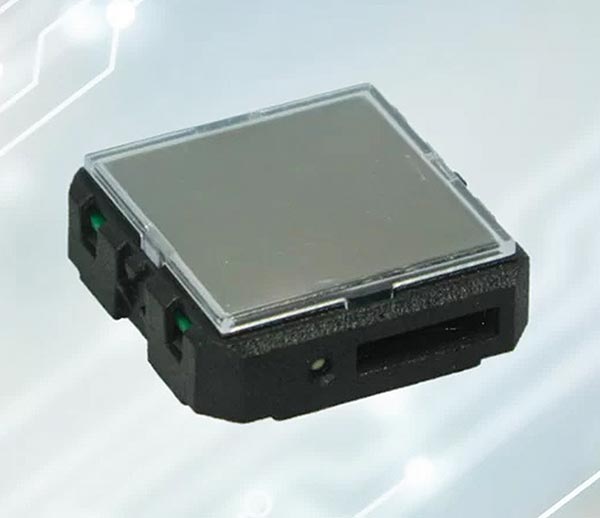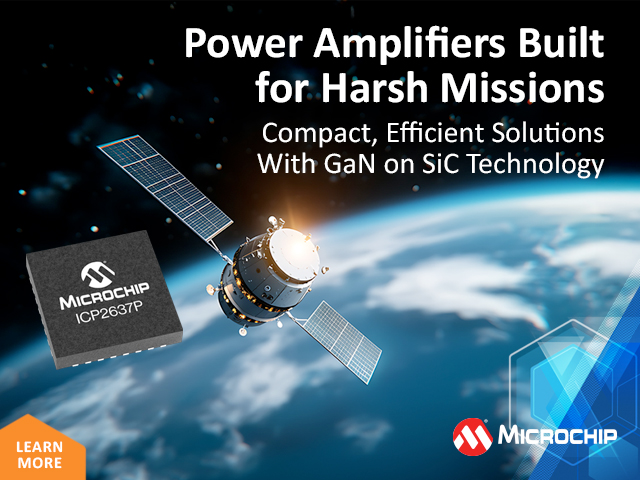 Modern building management systems can make a decisive contribution to greater energy efficiency and comfort. Smart lighting systems form the basis for a kind of central nervous system. Bluetooth usually forms the “neural pathways,” but other wireless standards also offer advantages. Smart lighting is one of the largest market sectors for Bluetooth: according to the “2021 Bluetooth Market Update” by Bluetooth SIG (Special Interest Group), 27% of shipped Bluetooth devices are already used for smart lighting. This puts them in second place behind smart appliance applications (35%), but they are growing faster than they are.
Modern building management systems can make a decisive contribution to greater energy efficiency and comfort. Smart lighting systems form the basis for a kind of central nervous system. Bluetooth usually forms the “neural pathways,” but other wireless standards also offer advantages. Smart lighting is one of the largest market sectors for Bluetooth: according to the “2021 Bluetooth Market Update” by Bluetooth SIG (Special Interest Group), 27% of shipped Bluetooth devices are already used for smart lighting. This puts them in second place behind smart appliance applications (35%), but they are growing faster than they are.
There are good reasons for this: connected lighting with a smart control can reduce energy costs by around 70 to 75%. At the same time, comfort levels are increased, for example by allowing users to change the colors of the light as desired or by automatically adapting the light to natural daylight (Human-Centric Lighting, HCL). This lighting concept provides a light spectrum that transitions from high blue components in the morning, which have an invigorating effect, to more red components in the evening, which have a calming effect.
Furthermore, presence detectors can be used, for example. Depending on whether someone is in the room or not, the light can be switched on or off automatically. Automatic switching based on the existing intensity of illumination or ambient light in a room is also possible.
Lighting is everywhere
Lighting is utilized virtually everywhere in a building. This makes it the obvious foundation for the infrastructure of new building management approaches, since the wireless technology integrated into the lighting control devices can also be used for numerous other applications. Bluetooth SIG predicts that by 2029 commercial connected lighting will generate $19.1 billion in global revenue.

Figure 1: Bluetooth SIG and DALI have defined a standardized gateway for controlling D4i luminaires via Bluetooth Mesh.
Together with the DALI (Digital Addressable Lighting Interface) Alliance, Bluetooth SIG has defined a gateway that allows D4i-certified luminaires to be monitored and controlled via Bluetooth Mesh. This way, lighting components from various suppliers can understand each other and interoperate smoothly.
Going beyond illumination, indoor location asset tracking or indoor navigation can, for example, be implemented using smart lighting. Objects that are to be tracked must be equipped with a beacon. The wireless transceiver in the luminaires receives its data signal as soon as the object is within range. The position of the object can then be derived using the building floor plan. This is particularly useful in warehouses or large factories, where it significantly reduces search times. Processes can thus be optimized and costs reduced. In hospitals, tracking can substantially contribute to increased speed and quality by easily locating mobile health-care equipment or hospital beds.
Networked via Bluetooth
Bluetooth Mesh is used by most smart lighting systems for reliable and secure communication. This allows the low power consumption rate and the low latency of Bluetooth Low Energy (LE) to be used for systems where hundreds or thousands of devices from various suppliers need to communicate with one another. Bluetooth Mesh uses the so-called flooding principle, which ensures messages reach their destination. This is possible as all the network participants can communicate directly with one another – and if one participant should fail, the message is transferred on via another route. In addition, smartphones can also be integrated into a BLE or mesh network with a corresponding app, thus enabling the switching of luminaires without a gateway or an Internet connection.
Bluetooth Mesh is supported, for example, by powerful multiprotocol SoCs from Nordic Semiconductor’s nRF52 and nRF53 series. In combination with the nRF21540, users can enjoy a 16× range extension. The nRF5340 is equipped with two Arm Cortex-M33 processors. The application processor is optimized for performance and can be clocked at either 128 or 64 MHz, has 1 MB Flash, 512 KB RAM, a floating-point unit (FPU), an 8 KB two-way associative cache, and DSP instruction capabilities. The network processor is clocked at 64 MHz and is optimized for low power and efficiency (101 CoreMark/mA). It has 256 KB Flash and 64 KB RAM. In addition to Bluetooth LE and Mesh, the nRF5340 also supports NFC, Thread, and Zigbee. It offers high-speed SPI, QSPI, USB, and an operating temperature of up to 221° F (105 °C).
Numerous suppliers offer modules based on these SoCs from Nordic Semiconductor. Many already have integrated antennas and are pre-certified for the key markets (CE, FCC, IC). As such, they help to shorten development time and reduce costs. This applies, for example, to the ISP series from Insight SiP, the PAN1780 and PAN1781 modules from Panasonic, the MBN52832 from Murata, and various modules from iVativ and EnOcean.
The ISP family from Insight SiP is characterized by its small form factor, which makes it particularly suitable for use in lighting applications. The modules are based on various Nordic ICs and can be exchanged easily thanks to pin compatibility.
The Panasonic PAN1780 module is based on the Nordic nRF52840-IC. Due to the integrated Arm Cortex-M4F with 1 MB Flash and 256 kB RAM, the module can be used in stand-alone mode, which helps to save costs and space. The PAN1781 is based on the Nordic nRF52820, which has 256 kB Flash and 32 kB RAM, and supports angle of arrival (AoA) and angle of departure (AoD) of version 5.1 of the Bluetooth Core Specification, so-called direction finding. This Bluetooth standard thus enables even more precise positioning.
The SX-ULPGN-BTZ module from Silex is based on the Qualcomm QCA4020 System-on-Chip (SoC). With dual-band 802.11 a/b/g/n Wi-Fi, Bluetooth LE and 802.15.4 connectivity (Zigbee, Thread Pro R21), it is also ideal for lighting and many other applications.
The supplier Cypress/Infineon also offers Bluetooth Mesh chips and modules suitable for lighting applications, for example the CYW20706 IC or the CYBT-343026-01 module, which is based on the CYW20706 IC.
Other wireless standards
In addition to Bluetooth LE and Bluetooth Mesh, other wireless standards are also common for smart lighting applications, such as the EnOcean standard, Thread, Zigbee, or Wi-Fi.
The advantage of Wi-Fi compared to Bluetooth is its significantly higher range. However, the resulting higher power requirement is perhaps also the biggest disadvantage of this technology. In addition, integrating luminaires into a Wi-Fi network is somewhat more complex, as a password and SSID (Service Set Identifier) must be entered for each luminaire. And a Wi-Fi network can reach its limits when lots of luminaires are connected.

Figure 2: The multisensor STM 550 from EnOcean for home automation and IoT applications is self-powered thanks to energy harvesting.
Zigbee can be used to create a large, robust mesh network. If a participant in the network fails, the information can be forwarded via an alternative route and is thus not lost. To set up the network, a bridge or hub is also required, which is connected to the WLAN router. The bridge or hub sends the (on/off) command to the luminaires via Zigbee. Unlike Bluetooth Mesh, data transmission is routed as varying tasks are assigned to the individual devices (coordinator, router, and end devices). This means that a certain path is specified for the data through the network.
Thread works in a similar way to Zigbee: here too, data distribution is routed, i.e. via a predefined path. Thread is a mesh protocol based on IPv6. This makes it relatively easy to integrate it into larger IP networks. The Thread protocol is also supported by the Nordic ICs and forms a perfect basis for Thread-based application layers such as Matter, HomeKit, DALI+, KNX IoT, OCF, etc.
The EnOcean sub-GHz wireless standard (868 MHz according to RED specification, 902 MHz according to FCC/IC specification, 928 MHz according to ARIB specification) offers high reliability by sending short telegrams. There is little collision probability within a network, thus enabling a large network of sensors. Further, there is no interference with DECT or WLAN. The use of a rolling code and 128 AES encryption ensures advanced data security. Inside buildings, the EnOcean wireless standard achieves a range of up to 30 meters.
The supplier EnOcean is particularly well known for its energy harvesting technology. It offers maintenance-free wireless sensors based on the EnOcean wireless standard as well as with Bluetooth and Zigbee. The new STM 550 IoT multisensor (Fig. 2) provides status information (open/closed) thanks to a magnetic contact and can measure temperature, humidity, acceleration/orientation, and illumination. The integrated solar cell produces enough energy for the measurements and to transmit the measurement data via Bluetooth, Zigbee, or the EnOcean standard, for example.
Conclusion
Be it Bluetooth, Bluetooth Mesh, EnOcean, WLAN, Thread, or Zigbee – all wireless standards have their specific advantages and disadvantages and which one is best suited for the relevant application needs to be decided individually. One thing applies to all though: they form the central nervous system for smart home lighting and thus for greater efficiency, convenience, comfort, and extensions, e.g. to include a navigation and tracking system.
Author: Kerstin Naser, Product Sales Manager Wireless
Rutronik | https://www.rutronik.com
![]()



